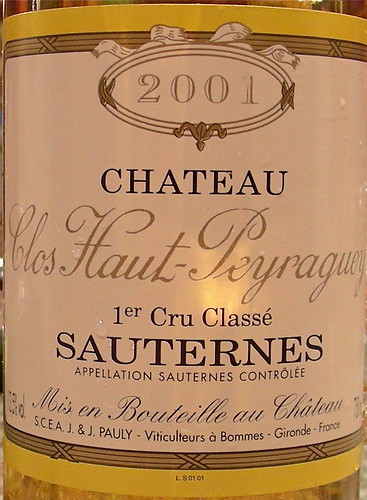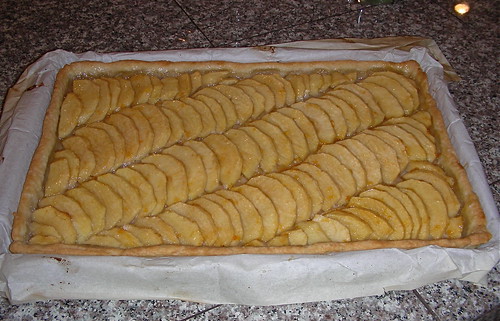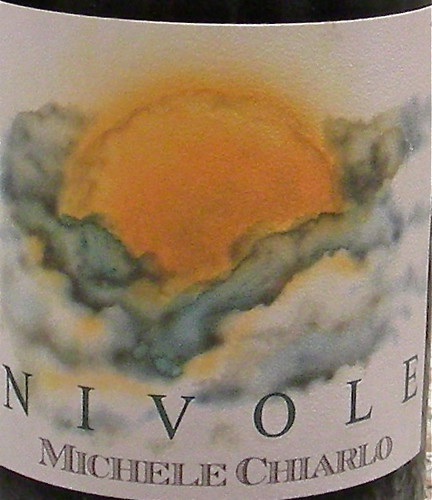The Right Bank is a large wine region that lies on the right side of the Dordogne river while facing the river downstream. It is made of 10 different appellations, including the prestigious appellations of Pomerol and Saint-Émilion. On the other hand, what we call the Left Bank is the region located on the left side of the Garonne river, north of Bordeaux. The Left Bank includes the Médoc and Graves districts.
The two banks differ mainly in soil composition. On the Left Bank, the soil is mostly gravels and wines are often dominated by Cabernet Sauvignon. On the Right Bank, the soil is made of clay, limestone and sand. Therefore, it is more suited to Merlot and to a lesser extent Cabernet Franc. Wines from the Right Bank tend to be fruit-forward with soft tannins and are more approachable than Left Bank wines when young.
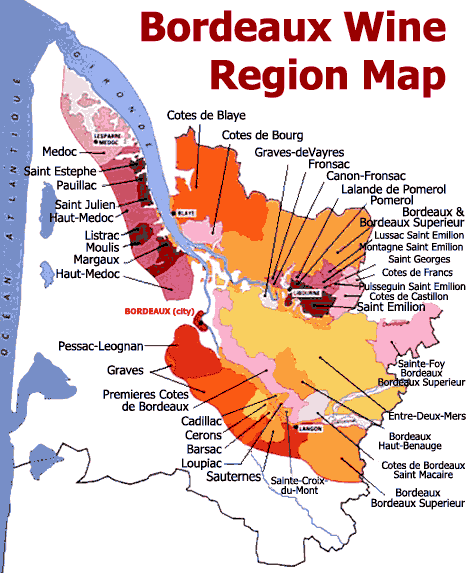
Bordeaux Wine Region
We tasted six wines from the appellations of Saint-Emilion, Lalande de Pomerol, Fronsac, and Côtes de Castillon. Four of them were from the warm 2005 vintage. The others were from 2004 and 2006. Overall, we found the wines tasty and food friendly although still young.
The wines we tasted:
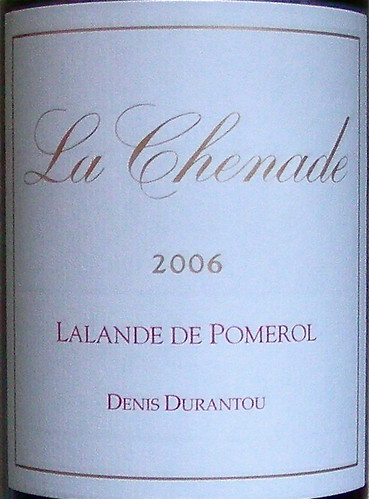 • 2006 Château La Chenade: this is a small property in the Lalande de Pomerol appellation, north of Pomerol. The wine is produced by Denis Durantou of renowned Château L'Eglise Clinet in Pomerol. The blend is Merlot 80%, Cabernet Franc 15%, Cabernet Sauvignon 5%. Our notes: subtle mineral nose with caramel notes, tight mid-palate, some acidity, earthy finish. Finished in fourth position.
• 2006 Château La Chenade: this is a small property in the Lalande de Pomerol appellation, north of Pomerol. The wine is produced by Denis Durantou of renowned Château L'Eglise Clinet in Pomerol. The blend is Merlot 80%, Cabernet Franc 15%, Cabernet Sauvignon 5%. Our notes: subtle mineral nose with caramel notes, tight mid-palate, some acidity, earthy finish. Finished in fourth position.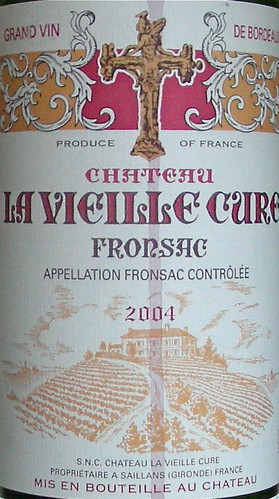 • 2004 Château La Vieille Cure: from the Fronsac appellation, west of Pomerol. Americans Colin Ferenbach and Peter Sachs bought the property in 1986, bringing a fresh investment of funds to lower the yields, select better fruit at harvest time, and buy new oak barrels, and winemaking equipment. The château has 20 hectares planted predominantly with Merlot (75%), the remaining being Cabernet Franc (22%) and Cabernet Sauvignon (3%). Our notes: dark color, discreet earthy nose, wood and acidity on the palate, slightly unbalanced, not as good as the others with food. Finished last.
• 2004 Château La Vieille Cure: from the Fronsac appellation, west of Pomerol. Americans Colin Ferenbach and Peter Sachs bought the property in 1986, bringing a fresh investment of funds to lower the yields, select better fruit at harvest time, and buy new oak barrels, and winemaking equipment. The château has 20 hectares planted predominantly with Merlot (75%), the remaining being Cabernet Franc (22%) and Cabernet Sauvignon (3%). Our notes: dark color, discreet earthy nose, wood and acidity on the palate, slightly unbalanced, not as good as the others with food. Finished last.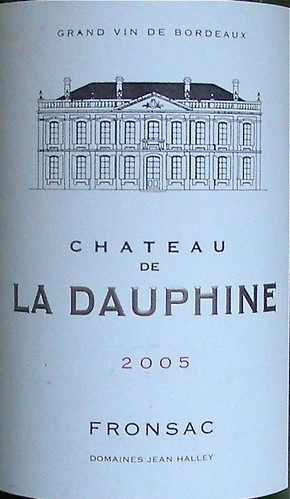 • 2005 Château de la Dauphine: from the Fronsac appellation, Château de la Dauphine has 37 producing hectares planted with 80% Merlot and 20% Cabernet Franc. The average age for the vines is 33 years old. The wine is aged in oak barrels (of which 1/3 are new) for 12 months. The last few years have seen significant investment both in the building itself and the vinification areas. Our notes: dark color, attractive spicy berry nose, full-bodied, mint and vanilla on the finish. Finished in second position.
• 2005 Château de la Dauphine: from the Fronsac appellation, Château de la Dauphine has 37 producing hectares planted with 80% Merlot and 20% Cabernet Franc. The average age for the vines is 33 years old. The wine is aged in oak barrels (of which 1/3 are new) for 12 months. The last few years have seen significant investment both in the building itself and the vinification areas. Our notes: dark color, attractive spicy berry nose, full-bodied, mint and vanilla on the finish. Finished in second position.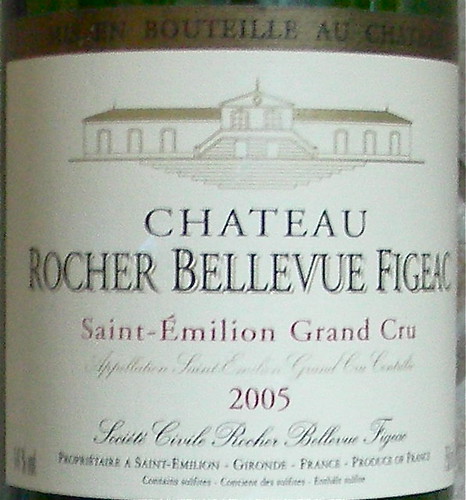 • 2005 Château Rocher Bellevue Figeac: a Grand Cru in the Saint Emilion appellation. The wine is a blend is 80% Merlot, 20% Cabernet Franc. it is aged 15-18 months in oak barrels, 40% of which are new. Our notes: peppery, smoky nose, full-bodied on the palate, a bit tannic but well rounded, long finish. Finished first, the wine was the clear winner of the tasting.
• 2005 Château Rocher Bellevue Figeac: a Grand Cru in the Saint Emilion appellation. The wine is a blend is 80% Merlot, 20% Cabernet Franc. it is aged 15-18 months in oak barrels, 40% of which are new. Our notes: peppery, smoky nose, full-bodied on the palate, a bit tannic but well rounded, long finish. Finished first, the wine was the clear winner of the tasting. • 2005 Château Joanin-Bécot: from the Côtes de Castillon appellation, east of Saint Emilion and south of Fronsac. It is owned by the Bécot family of Château Beau-Séjour Bécot in Saint Emilion. The wine is a blend of 75% Merlot and 25% Cabernet Franc, aged in oak barrels 70% new. Our notes: forward nose with dairy and mineral aromas, young and tannic on the palate. Finished in third position.
• 2005 Château Joanin-Bécot: from the Côtes de Castillon appellation, east of Saint Emilion and south of Fronsac. It is owned by the Bécot family of Château Beau-Séjour Bécot in Saint Emilion. The wine is a blend of 75% Merlot and 25% Cabernet Franc, aged in oak barrels 70% new. Our notes: forward nose with dairy and mineral aromas, young and tannic on the palate. Finished in third position. 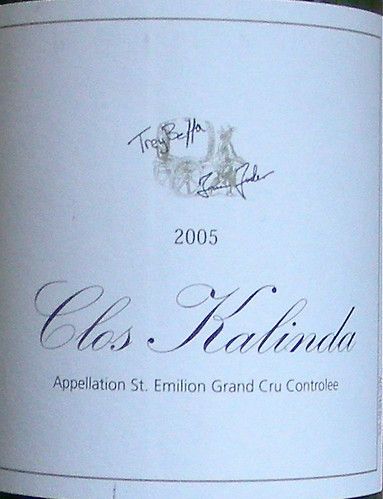 • 2005 Clos Kalinda Saint Émilion: this is the first Bordeaux wine under the Kalinda label from K&L Wine Merchants. It is produced by Château Sansonnet in Saint Emilion. The property's second wine (in France, Lasalle) was used as a base for the wine with also some Sansonnet in the blend. Our notes: subtle vanilla nose with sweet fruit aromas, good mid-palate, shorter finish, good with food. Finished in fifth position.
• 2005 Clos Kalinda Saint Émilion: this is the first Bordeaux wine under the Kalinda label from K&L Wine Merchants. It is produced by Château Sansonnet in Saint Emilion. The property's second wine (in France, Lasalle) was used as a base for the wine with also some Sansonnet in the blend. Our notes: subtle vanilla nose with sweet fruit aromas, good mid-palate, shorter finish, good with food. Finished in fifth position.Previous blind wine tastings:
• Blind Tasting of Syrah
• Blind Tasting of Cabernet Blends from Washington State
• Blind Tasting of Pinot Noir from Los Carneros and Anderson Valley
Technorati tags: wine food & drink



